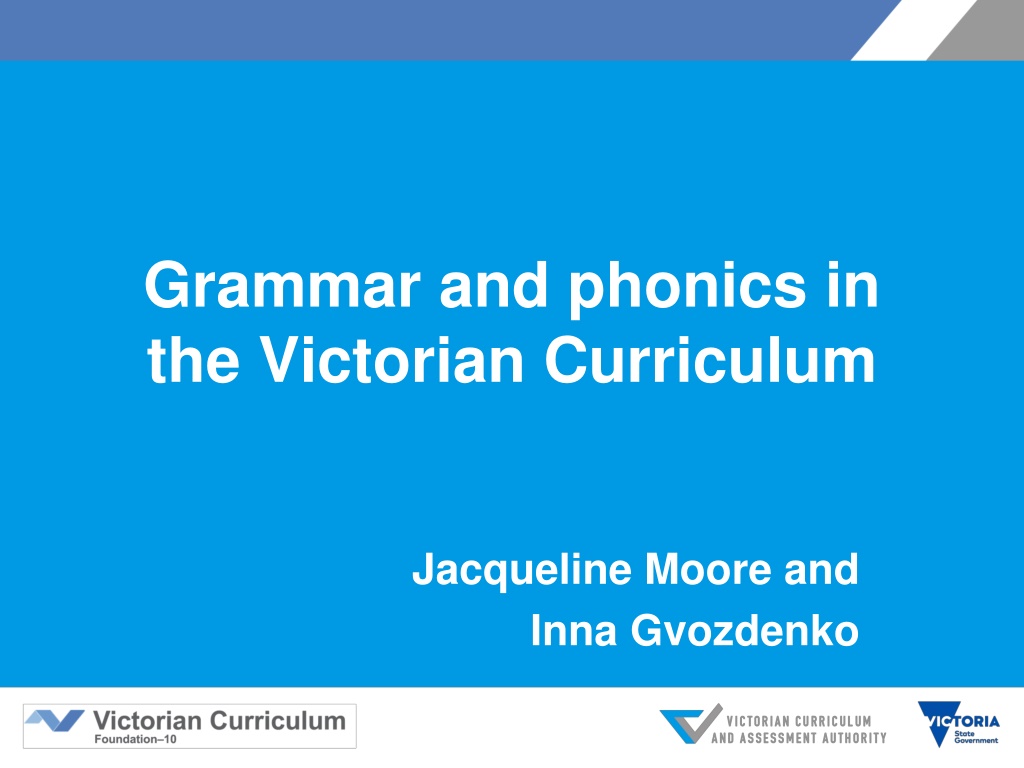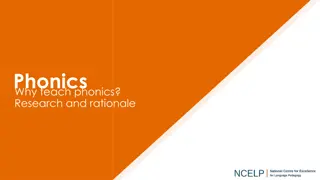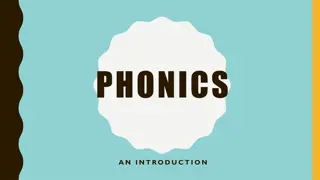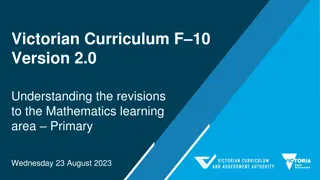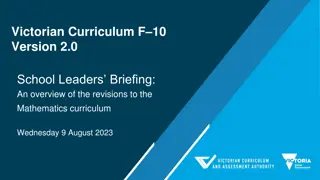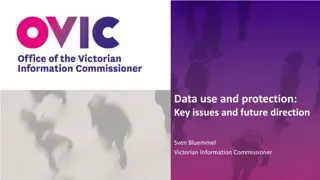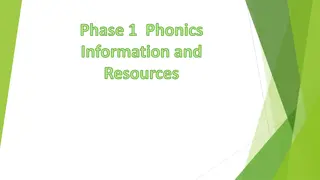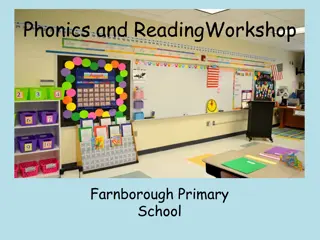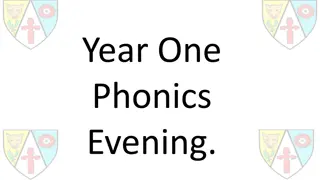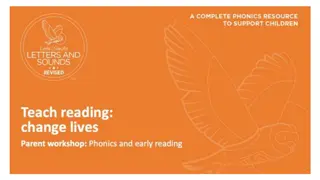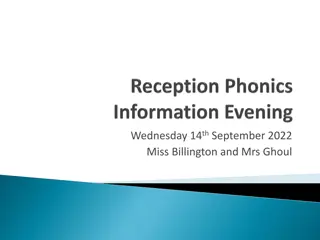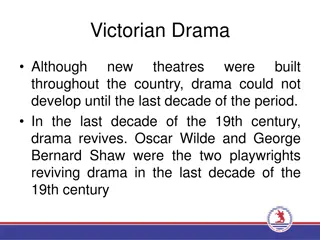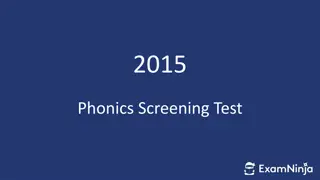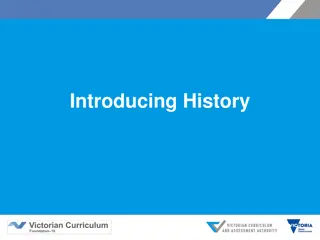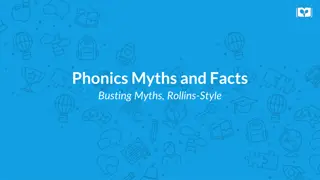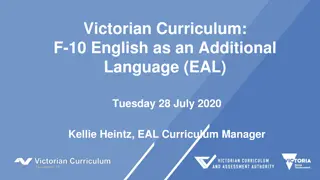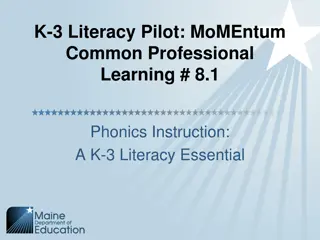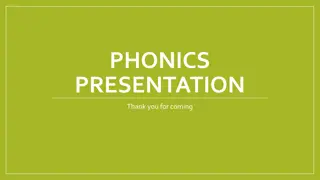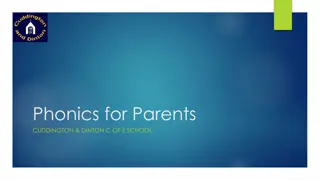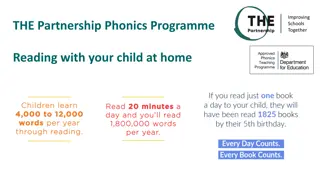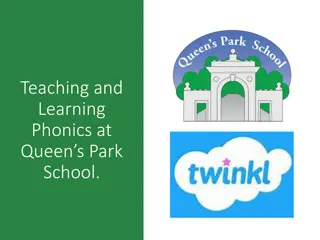Exploring Grammar and Phonics in the Victorian Curriculum
This insightful discussion delves into the integration of grammar and phonics in the Victorian Curriculum, offering practical approaches for educators. It explores the importance of phonics, phonemic awareness, and sound-letter knowledge in language development. The content emphasizes the value of understanding phonemes, phonological knowledge, and the relationship between letters and sounds. Additionally, it explains the key focus areas in phonics education and highlights the essential skills students need to develop at different curriculum levels.
Uploaded on Sep 13, 2024 | 0 Views
Download Presentation

Please find below an Image/Link to download the presentation.
The content on the website is provided AS IS for your information and personal use only. It may not be sold, licensed, or shared on other websites without obtaining consent from the author. Download presentation by click this link. If you encounter any issues during the download, it is possible that the publisher has removed the file from their server.
E N D
Presentation Transcript
Grammar and phonics in the Victorian Curriculum Jacqueline Moore and Inna Gvozdenko
Aims to consider the place of grammar and phonics in the Victorian Curriculum to share some practical approaches for integrating grammar and phonics teaching into existing teaching and learning programs
Part I: Phonics in the Victorian Curriculum Sound and Letter Knowledge sub-strand (previously in the Language strand) renamed Phonics and Word Knowledge and made up of three focus areas: Phonological and Phonemic Awareness Phonics and word knowledge Spelling Content descriptions in the Handwriting focus area have been revised to make the connection between phonics and handwriting more explicit.
Defining Terms Phonemic awareness is the ability to notice, think about, and work with the individual sounds in spoken words. E.g. ZZZ is for Zebra! Zebra starts with ZZZ . Phoneme is the smallest unit of sound in a word. The word is has two phonemes /i/ and /s/. E.g. changing the first phoneme in the word rat from [r] to [b] changes the word from rat to bat , so changes the meaning. Phonological knowledge is the information about the sounds of language and letter-sound relationships, e.g. single sounds, blends. E.g. A child can see smaller words within larger words: cat in catalogue . (http://ausvels.vcaa.vic.edu.au/static/docs/english.pdf)
Defining Phonics Phonic refers to the ability to identify relationships between letters and sounds when reading and spelling. The English language has 44 phonemes (sounds), but only 26 letters (graphemes). Some sounds are represented by multiple letters, e.g. Letters TH make the sound [th] in the word teeth.
Phonics in the Victorian Curriculum Strand: Reading and Viewing Sub-strand: Language Foundation Recognise all upper- and lower-case letters and the most common sound that each letter represents (VCELA146) Level 1 Understand that a letter can represent more than one sound, and that a syllable must contain a vowel sound (VCELA183) Level 2 Recognise most letter sound matches including silent letters, trigraphs, vowel digraphs and common long vowels, and understand that a sound can be represented by various letter combinations (VCELA218)
Phonics Instruction Approaches Synthetic phonics Description Children learn how to convert letters or letter combinations into sounds, and then how to blend the sounds together to form recognizable words. Children learn to analyse letter-sound relationships in previously learned words. They do not pronounce sounds in isolation. Children learn to use parts of word families they know to identify words they don t know that have similar parts. Children learn to segment words into phonemes and to make words by writing letters for phonemes. Children are taught letter-sound relationships during the reading of connected text. (Since children encounter different letter-sound relationships as they read, this approach is not systematic or explicit.) Children learn to identify the sound of the letter or letters before the first vowel (the onset) in a one-syllable word and the sound of the remaining part of the word (the rime). (Armbruster, B.B., et. al, 2001) Analytic phonics Analogy-based phonics Phonics through spelling Embedded phonics Onset-rime phonics
Classroom Ideas Alphabet Knowledge Instruction http://blogs.ksbe.edu/katakaku/files/2014/08/EnhancingABCKnowledgeInst ructionUSU.pdf Teaching Elementary Spelling https://www.youtube.com/watch?v=CC49635RVI0
Strand: Writing Sub-strand: Language Foundation Understand that spoken sounds and words can be written and know how to write some high- frequency words and other familiar words including their name (VCELA157) Level 1 Recognise and know how to use simple grammatical morphemes in word families (VCELA191) Level 2 Understand how to use digraphs, long vowels, blends, silent letters and syllabification to spell simple words including compound words (VCELA226) Understand how to use learned formation patterns to represent sounds and write words using combinations of unjoined upper- and lower-case letters (VCELY196) Know how to use onset and rime to spell words where sounds map more directly onto letters (VCELA158)
Spelling Words Correctly Breaking the words into parts /clapping the sounds. going go/ing (2 syllables) returned re turn ed (3 syllables) Learn how to spell words that look the same. Compare Suffix ly Meaning In the manner Example Happily Steadily Briefly Non-example Assembly Family Ugly
Strand: Reading and Viewing Sub-strand: Language Level 5 Level 6 Understand how to use banks of known words, syllabification, spelling patterns, word origins, base words, prefixes and suffixes, to spell new words, including some uncommon plurals (VCELA312) Identify the relationship between words, sounds, imagery and language patterns in narratives and poetry such as ballads, limericks and free verse (VCELT344)
Effective Teaching Strategies Short instructional session - 10 to 30 minutes Small groups Focus on 2 or 3 phonemic awareness Personalised instruction Revision of the material covered before Teaching with letters
What is the Research Evidence? Phoneme awareness performance is a strong predictor of long-term reading and spelling success and can predict literacy performance more accurately than variables such as intelligence, vocabulary knowledge, and socioeconomic status (Gillon, 2004: 57) for students to develop excellent reading and spelling skills they must also develop excellent phonemic awareness skills (Armbruster, B; Lehr, F.; Osborn, J.,2001) Direct Instruction has been found the most effective teaching strategy (Hattie, J.,2012).
Teaching High Frequency Words Learning Time Fun https://www.youtube.com/watch?v=xBzH7gAztaI
Strand: Speaking and Listening Sub-strand: Examining Literature Foundation Level 1 Level 2 Replicate the rhythms and sound patterns in stories, rhymes, songs and poems from a range of cultures (VCELT172) Listen to, recite and perform poems, chants, rhymes and songs, imitating and inventing sound patterns including alliteration and rhyme (VCELT209) Identify, reproduce and experiment with rhythmic, sound and word patterns in poems, chants, rhymes and songs (VCELT243)
Classroom application Jazz Chants Your https://www.youtube.com/watch?v=Jw2RHq82sYU Hands
Strand: Writing Sub strand: Language Level 7 Level 8 Level 9 Understand how to use spelling rules and word origins to learn new words and how to spell them (VCELA384) Understand how to apply learned knowledge consistently in order to spell accurately and to learn new words including nominalisations (VCELA417) Understand how spelling is used creatively in texts for particular effects, for example characterisation and humour and to represent accents and styles of speech (VCELA434)
British Accent in Harry Potter https://www.youtube.com/watch?v=FJeqp4O1WlM Prompt questions: Why has the author given her character/s an accent? How does accent affect the meaning of the visual text? What strategies does a reader use when reading or viewing accented dialogue? What feelings does the accented dialogue evoke in the reader/viewer? How does the accent make you feel about the characters?
Strand: Writing Sub-strands: Examining Literature and Language Level 6 Identify the relationship between words, sounds, imagery and language patterns in narratives and poetry such as ballads, limericks and free verse (VCELT344) Level 7 Understand how to use spelling rules and word origins to learn new words and how to spell them (VCELA384)
Narrative: Left. Right. Left. Right. .Grandfather caught Justin s eye and gave him a meaningful nod, as the boy sat by grandfather s side. Silence filled the air, a silence of pure wisdom. The only thing that could be heard was the obstructive ticking of the clock that kept time with grandfather s beating heart. Thump-thump. Thump-thump. At that point the curtain opened revealing the bitter truth. My vision was blurred and I could discern Justin s eyes glistening as well. For the first time it dawned me we may have something in common after all. There we remained. The three of us, side by sided. Tick- tock. Tick- tock. Tick- tock. Thump-thump. Thump-thump. Thump-thump. Thump. ( Katie, Year 7)
To conclude ..for children .to be able to link their knowledge of spoken language to their knowledge of written language, they must first master the alphabetic code the system of grapheme-phoneme correspondences that link written words to their pronunciations. (Teaching Reading, National Inquiry into the Teaching of Literacy, 2005:42)
Part II: Grammar in the Victorian Curriculum What is grammar? The way a structure of a language works to create meaning within texts. The rules of a language that reflect the way it is used at a particular time.
Why teach grammar? Grammar is how we organise our words and sentences to communicate with others and to express ourselves. All children deserve to be able to use language with intention and effect, for any purpose and in all circumstances. Indeed their capacity to do so is what they are assessed on everyday at school, so if teachers don t teach what school is assessing we are being negligent. Adoniou, M (2014) http://theconversation.com/grammar-matters-and-should-be-taught-differently-25604
Which grammar? form relating form and function e.g. systemic-functional grammar function e.g. notional-functional e.g. traditional grammar Derewianka, B & Jones, P (2010) From traditional grammar to functional grammar: bridging the divide
What is the place of grammar in the Victorian Curriculum? Grammar is embedded in all three modes and across all three strands Language strand how the English language works Literacy applying developing knowledge of grammar to create texts for a range of purposes Literature using texts to examine how authors use language to achieve their purposes
Grammar in the Victorian Curriculum Levels F-2 Grammar is learned best when it is supported through oral language is taught through reading/writing not in isolation is integrated into the revising and editing process allows students to experiment and play with sentences
Strand: Reading and Viewing Sub-strand: expressing and developing ideas Level 1 Level 2 Identify the parts of a simple sentence that represent What s happening? , Who or what is involved? and the surrounding circumstances (VCELA178) Understand that simple connections can be made between ideas by using a compound sentence with two or more clauses usually linked by a coordinating conjunction (VCELA214)
Strand: Reading and Viewing Sub-strand: expressing and developing ideas Level 1 Level 2 Explore differences in words that represent people, places and things (nouns, including pronouns), happenings and states (verbs), qualities (adjectives) and details such as when, where and how (adverbs) (VCELA179) Understand that nouns represent people, places, things and ideas and include common, proper, concrete or abstract, and that noun groups/phrases can be expanded using articles and adjectives (VCELA216)
Suggested classroom approaches Levels F-2 Grammar in the context of children s literature by Jayashankar, K (2012) in Primarily English Volume I, No. 2 pp26-9
Strand: Writing Level 3 Level 4 Understand that a clause is a unit of grammar usually containing a subject and a verb and that these need to be in agreement (VCELA261) Understand that the meaning of sentences can be enriched through the use of noun groups/phrases and verb groups/phrases and prepositional phrases (VCELA292) Reread and edit for meaning by adding, deleting or moving words or word groups to improve content and structure (VCELY300) Understand that paragraphs are a key organisational feature of written texts (VCELA259)
Suggested classroom approaches Levels 3-6 Misty Adoniou YouTube clip https://www.youtube.com/watch?v=nu8dw8lkBLQ
The building blocks of a text. They are made up of word groups and join together to form sentences. Clauses Peter danced very gracefully. The building collapsed. Statement Question Command Exclamation Made up of a single clause only The building collapsed. Peter danced. What did Peter do? Dance, Peter. That s great! Types of clauses (simple sentences) Simple sentence She wrote him a letter. He went to the party but I stayed home. Made up of two or more independent clauses of equal importance. They are often linked together by a conjunction. Could stand alone. Made up of a main clause and an independent clause. Depends on, or requires the presence of, another clause to which it is attached in some way. Compound sentence Peggy frequently calls because she wants to stay in touch. The dealer promised that my car would be fixed for free. Complex sentence Dependent clause
Grammar in the Victorian Curriculum Levels 7-8 Level 7 Writing Level 8 Reading Recognise and understand that subordinate clauses embedded within noun groups/phrases are a common feature of written sentence structures and increase the density of information (VCELA382) Analyse and examine how effective authors control and use a variety of clause structures, including clauses embedded within the structure of a noun group/phrase or clause (VCELA400)
Using literature to teach grammar Harry Potter was a highly unusual boy in many ways for one thing he hated the summer holidays more than any other time of year for another he really wanted to do his homework but was forced to do it in secret in the dead of night and he also happened to be a wizard
Using literature to teach grammar Harry Potter was a highly unusual boy in many ways. For one thing, he hated the summer holidays more than any other time of year. For another, he really wanted to do his homework, but was forced to do it in secret, in the dead of night. And he also happened to be a wizard.
Questions and Feedback Jacqueline Moore | English Curriculum Manager T: (03) 9032 1691 E: : moore.jacqueline.j@edumail.vic.gov.au Inna Gvozdenko | Assistant Principal, NPELS E: gvozdenko.inna.v@edumail.vic.gov.au
